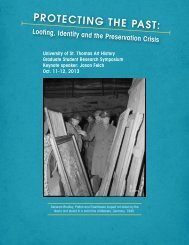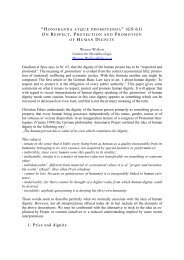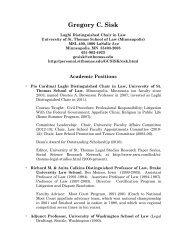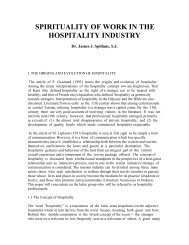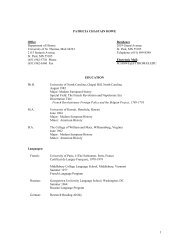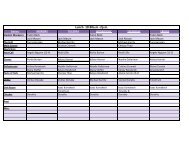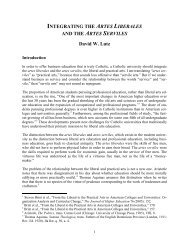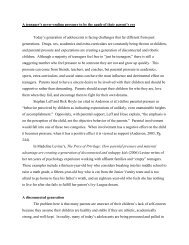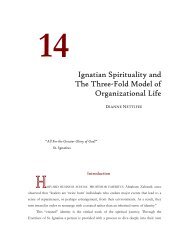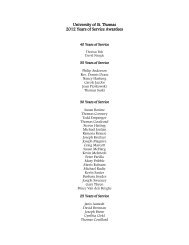dr. ronald e. mcnair acknowledgements - University of St. Thomas
dr. ronald e. mcnair acknowledgements - University of St. Thomas
dr. ronald e. mcnair acknowledgements - University of St. Thomas
You also want an ePaper? Increase the reach of your titles
YUMPU automatically turns print PDFs into web optimized ePapers that Google loves.
UST McNair Scholars Program Research Journal<br />
information, and provided a link to the online survey.<br />
Posting the study in the daily online bulletin allowed the<br />
researcher to contact students not on campus during the<br />
summer session. Paper posters were placed near campus<br />
dining halls, student centers, and residence halls. Finally,<br />
the researcher created a facebook invitation to recruit<br />
volunteers for the anonymous online survey. Each <strong>of</strong> the<br />
recruitment methods informed students <strong>of</strong> a <strong>dr</strong>awing for<br />
two $25 gift cards to the campus bookstore upon<br />
completion <strong>of</strong> the survey.<br />
MATERIALS AND PROCEDURE<br />
The study methods were adapted from procedures used<br />
by Nolan and colleagues (2008) in their experiment (<strong>St</strong>udy<br />
2) examining California residents’ motivations to conserve<br />
energy. Qualtrics Survey S<strong>of</strong>tware hosted the online survey.<br />
Participants logged on and were presented with a consent<br />
form that included the purpose <strong>of</strong> the study, contact<br />
information <strong>of</strong> the researcher, and the option to with<strong>dr</strong>aw<br />
from the study at any point. After indicating their consent<br />
to participate, students were randomly assigned to an<br />
experimental condition in which they were presented with<br />
a scenario and then asked to answer a set <strong>of</strong> questions. The<br />
study used a 2x5 factorial design. The first independent<br />
variable, with two levels, was the presence or absence <strong>of</strong> an<br />
image accompanying the text scenario. The second<br />
independent variable was the type <strong>of</strong> message. There were<br />
five message conditions, each presenting a different reason<br />
for reducing wasted food: descriptive norm, self interest<br />
(economic), environment, social responsibility, or<br />
informational control. All message conditions except the<br />
information only conditions contained motivational<br />
information as to why the student should reduce the<br />
amount <strong>of</strong> food they waste. In addition to varying the<br />
message, half <strong>of</strong> the participants were shown a picture <strong>of</strong><br />
food waste in a cafeteria setting, while the other half<br />
received no picture along with the message (see Figure 1).<br />
Each participant was then asked “How much did the<br />
information provided motivate you to reduce the amount<br />
<strong>of</strong> food you waste?” They then responded to a series <strong>of</strong><br />
statements to assess their perceived psychological distance<br />
to the issue <strong>of</strong> food waste. The set <strong>of</strong> 19 statements<br />
described their personal reactions to the idea <strong>of</strong> food wasted<br />
on campus and students indicated their level <strong>of</strong> agreement<br />
with each one. As part <strong>of</strong> the personal reactions measure,<br />
52<br />
participants then were asked to write-in three words that<br />
came to mind when they thought <strong>of</strong> food waste. Finally,<br />
the survey concluded with a demographic section to give a<br />
general picture <strong>of</strong> who took the survey. When participants<br />
reached the end <strong>of</strong> the survey, they read a message thanking<br />
them for their participation and were shown a debriefing<br />
page.<br />
RESULTS<br />
These preliminary results are based on 239 responses.<br />
Participants were asked “How much did the information<br />
in this message motivate you to reduce food waste on<br />
campus?” with responses ranging from 1 (not at all) to 4<br />
(extremely). Participants rated the environmental message<br />
(M = 2.35, SD = .80) as the most motivational for<br />
conditions with no picture present, followed by the<br />
financial self interest message (M = 2.29, SD = .64) and<br />
the social responsibility message (M = 2.25, SD = .55).<br />
The descriptive social norm message (M = 2.05, SD = .80),<br />
and the informational control message (M = 1.95, SD =<br />
.70) were rated as the least motivational by participants for<br />
conditions with no picture present.<br />
Participants rated the financial message (M = 2.62, SD<br />
= .88) as the most motivational for conditions with a<br />
picture present, followed by the social responsibility<br />
message (M = 2.56, SD = .77) and the environmental<br />
message (M = 2.25, SD = .99). Once again, the descriptive<br />
social norm message (M = 2.16, SD = .69) and the<br />
informational control message (M = 1.96, SD = .82) were<br />
rated as the least motivational by participants for<br />
conditions with a picture present.<br />
Overall, participants rated the financial messages (M =<br />
2.47, SD = .79) as being the most motivational, followed<br />
by the social responsibility messages (M = 2.42, SD = .69)<br />
and the environmental messages (M = 2.31, SD = .88).<br />
Participants rated the descriptive social norm messages (M<br />
= 2.12, SD = .73) and the informational only messages (M<br />
= 1.95, SD = .76) as being the least motivational overall<br />
(refer to Table 1).<br />
Pairwise comparisons showed that the scores for the<br />
information control conditions were significantly lower<br />
than those in the financial self interest conditions (t = -<br />
.503, p = .003), the environmental conditions (t = -.350,



